Hardware
Door Lock Repair
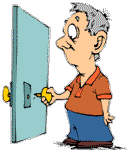 Repairing door locks is a common problem. Sometimes the locks themselves malfunction and need repair or replacement. Other time the door gets out of alignment and the locks won't operate correctly.
Repairing door locks is a common problem. Sometimes the locks themselves malfunction and need repair or replacement. Other time the door gets out of alignment and the locks won't operate correctly.
Not sure if the lock is your problem? See the article 'How To Fix Doors' for a list of all the door repair topics. Some popular lock repair topics are 'Replacing Door Locks', 'Adjusting Door Strike Plates' and 'Lubricating Door Locks'. Follow these links for more information.
Purpose of Door Locks
Door locks and door knobs provide various functions for the door. They give you something to grip while opening or closing the door. They provide varying levels of security. For instance a bedroom door may have a privacy latch that you can open with a bobby pin in a jamb. Your front door may have both a lock and a deadbolt, to keep strangers out.
Door locks have moving parts and therefore, can stop working or not work well. The door lock also aligns with other features on the door, and can not work if the alignment is not good. Door locks also provide an architectural element in the home. It could be that your door lock repair is actually a door lock replacement. There are some things that can be done to repair door locks. Tightening, adjusting and lubricating are simple fixes that can get things working. Read on and learn which door lock repairs you can do yourself.
Door Lock Repair - Information
What Can You Save?
To have someone come out and take care of a door lock for you should cost between $50 and $100. That is assuming that you don't have a more serious problem or the repairman convinces you that you have a serious problem. Getting sold on a new door could cost several hundred dollars. Much cheaper to make your own door lock repair.
How Hard Could It Be?
Door lock repairs are not that difficult and do not require exceptional skill.
For and explanation of the terms in this section, see 'How to Use This Site'.
Check the Simple Things!
The simplest thing with a door lock would be lubrication. Locks that stick or are hard to operate may need to be oiled. Take a look at Step Four, you may be able to save some time. A door lock repair could be that easy.
What Can Go Wrong?
The worst thing that could happen is that you will take a lock that is working poorly and turn it into a lock that does not work. For an exterior door, this could leave you with no way to lock the door. Replacement locks are fairly inexpensive and you could probably get a new one and change it in short order. Temporarily bar the door if it is too late.
Troubleshooting Door Lock Problems
The article 'Troubleshooting Door Lock Problems' discusses what to look for when your lock is malfunctioning. It can be the lock itself or it may be that the door is not aligned properly.
The article 'How To Fix a Door Knob' has information on fixing the door knob itself.
Many times it is not the lock that is the problem. 'Adjusting Interior Doors' and 'Adjusting Exterior Doors' shows you how to align the door so that the door lock works correctly.
'Adjusting Door Strike Plates' is the article that tells you how to move this plate. It may not be neccessary to move the plate if the door is adjusted correctly. See the links above for adjusting doors.
The easiest thing to do with a door lock is to lubricate it. This will solve most problems. 'Lubricating Door Locks' gives you all the information you need.
As a last resort, 'Replacing Door Locks' tells you what you need to know about getting a new lock.
Summary
You probably have many door locks and door knobs in your home. The inner workings of a door lock are usually not practical to try and repair, unless it is a high end commercial lock.
The good news is that even if you can't get your door lock working, a replacement is not that expensive. We hope you were successful with your door lock repair. Now you can move on to other projects or just relax.
Adjusting Door Hinges
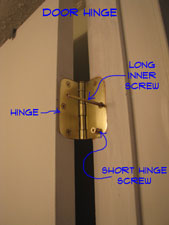 Adjusting door hinges may not be the first fix you would think of when you are having a problem with a door. At first when you look at door hinge, you think that there is no way to adjust them. In a sense, that is true. However, you can change the position of the hinge by using it to adjust the door jamb slightly.
Adjusting door hinges may not be the first fix you would think of when you are having a problem with a door. At first when you look at door hinge, you think that there is no way to adjust them. In a sense, that is true. However, you can change the position of the hinge by using it to adjust the door jamb slightly.
Is this not your problem? See the article 'Fixing and Troubleshooting Doors' for a complete listing of all of the door topics.
How Door Hinges Support the Door
How can you make a door hinge repair when the hinges are sagging and the door will not close? To understand the answer to this question, you need to understand how the hinges support the door.
When a door has three hinges you might think, that each hinge is doing a third of the work. That would be fair, but it is not true. Of the three, the top hinge does the majority of the work. The bottom hinge acts as a fulcrum and the door will tend to sag, pulling at the top hinge.
Problems With Hinges
Top Hinge Issues
A top hinge that only has short screws attached to the frame will start to pull away in time. The frame itself may pull with the hinge. When this happens the door will sag, the top edge of the door on the strike side will start to rub against the frame. This makes the door difficult to close and can leave gaps where daylight comes in.
Door Hinge Mortise Problems
The mortise is the area of wood that is milled or chiseled away to allow the hinge to inset into the door or jamb. Problems can occur when the mortise is too deep or to shallow. This is not common on doors that machined at the factory. It is more common on hinges that are mortised and installed by hand.
A mortise that is too deep can cause the door to have too large a gap against the frame on the strike side. It can also cause the door to bind against the jamb, making it difficult to close. This is a fairly easy problem to fix, you can pack out the hinge with thin cardboard to get the hinge set at the right depth. See the section on 'Packing Out a Hinge' below.
A shallow mortise, will cause the opposite problem. The door might not fit in the opening correctly and may bind against the frame on the strike side. If you have this problem, you can deepen the mortises with a chisel. See the section on 'Mortising a Hinge' below.
Incorrect Hinge Installation
Again, this only occurs with hinges that are altered or installed in the field. Everything about the location of a hinge is important. The size of the hinge needs to be matched to the door, see 'Door Hinge Sizes', both for weight and thickness of the door.
The spacing of the hinges on the door must match the spacing of the hinges on the jamb. There is an inset and a backset for a door hinge. Too much inset/backset and the door will be too tight against the stop and may not close. Too little inset/backset and the door will have gaps at the door stop.
To avoid these types of problems, you should use replacement hinges that are the same size as the old ones. It is not a good idea to try and re-work the mortises to use hinges that are a different size. See the article 'Installing Door Hinges' for more information.
When mortising a new door slab to an existing opening, use extreme caution when locating the hinges. Try to use the old door as a template to get the spacing and backset correct prior to cutting the mortise.
Adjusting Hinges
The key to adjusting door hinges is the top hinge. You need at least one long screw that goes into the wood jamb that holds up the frame. If you are working on an exterior door you want to see the article 'Adjusting Entry Doors' for instructions on how to do this. For interior doors, see the article 'Adjusting Interior Doors'. Both of these articles provide tips on getting the door to set properly in the opening.
Packing a Hinge
To pack out a hinge you can loosen the hinges, (one at a time) and put one or more thin layers of cardboard (this should be dense cardboard, like the kind used for cereal boxes or similar) underneath the hinge.
The effect that the shims will have on the door are somewhat exponential. You do not necessarily need an 1/8" shim to correct an 1/8" gap. It will likely be less than that, depending on where the gap is.
Cut some pieces of thin dense cardboard, slightly smaller than the mortise for the hinge. Try one shim at a time until you get the door aligned the way you want.
Mortising a Hinge
Whoa!! Why do you want to do this. There are a few legitimate reasons, but most of the time this is not needed.
Replacing Hinges
Do not get hinges for replacement that are a different size than the ones that were on the door. If you can't find the right size, go online to find them. See the article 'Door Hinge Sizes' and 'Door Hinge Types' for information on how hinges are sized and how to obtain them. See the article 'Installing and Replacing Door Hinges' for the best practices on replacing hinges.
Getting the mortises right by hand is difficult, so going at your door or jamb with a hammer and chisel is not a great idea.
Replacing a Door Slab
A legitimate reason may be matching a new door slab to an existing opening. For this I recommend getting a door hinge template kit. You can use a regular router and a special bit to cut the mortises. The better kits will have all the templates and accessories you need for whatever hinge size you have.
You can get a kit for around forty dollars. They include the templates that attach to the door or frame, a special router bit, corner mortising chisels if needed and charts on how to locate the hinges.
Summary
The hinges are an important component for any swinging door. When they are out of adjustment, the door will not operate correctly. There are things you can do with the hinges that will get the door aligned properly.
Door Hinge Repair
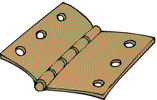 Door hinge repair is a common task for homeowners. The hinges support the weight of the door and give it a way to swing in and out of an opening. They are the main moving part of a door and do all the hard work. Hinges can wear out and will need attention. What can you do?
Door hinge repair is a common task for homeowners. The hinges support the weight of the door and give it a way to swing in and out of an opening. They are the main moving part of a door and do all the hard work. Hinges can wear out and will need attention. What can you do?
Not sure if this is your problem? See the article 'How To Fix a Door' for a complete listing of all the door related topics.
There are three main areas with door hinge repair. Lubricating, adjusting and replacing them are the options. These repairs get harder as they go. Lubricating a sticky or squeaky door hinge is the easiest job. Adjusting a hinge is also not that hard. Replacing hinges is a bit more work, but still not a major job.
Check out this information to see if this is something you want to take care of. You may be pleasantly surprised, it may only take a few minutes of your time.
Door Hinge Repair - Information
What Can You Save?
Lubricating squeaky or sticking door hinges and adjusting the door should run from $50 to $75. Replacing a set of hinges may run $100. It will be more if the hinges have to be fit to the door.
How Hard Could It Be?
Door hinge repairs are not too hard and usually only take a few minutes.
For and explanation of the terms in this section, see 'How to Use This Site'.
Check the Simple Things!
Lubricating the hinges is the easiest thing. Squeaky or sticking hinges can usually be taken care of by some oil.
What Can Go Wrong?
Be careful when using oil or graphite on a door hinge. Oil can leak and get on other surfaces. Graphite is a dry black powder that can stain walls and carpet. When adjusting a door hinge it is possible to make the situation worse, not better. A door that is too far out of adjustment will not close.
Troubleshooting Door Hinge Problems
Oiling or lubricating is the solution most of the time when it comes to troublesome hinges. The article 'Oiling Door Hinges' gives you instructions on what to do.
The hinges hold the door in the frame. Hinges that are not attached securely will allow the door to sag. The article 'Adjusting Door HInges' talked about how to correct this problem.
Hinges that are too discolored or too rusty may need to be replaced. The article 'Replacing Door Hinges' gave you instructions on what to do.
Are you all done with your door hinge repair? What did you have to do? Hopefully you were in the majority and all that was needed was some lubrication. A few minutes with the right oil and you have solved your problem. The next easiest door hinge repair involves adjusting the hinges. This is usually confined to the top hinge.
Were you left with the task of replacing your door hinges? This is a little more work, but not impossible to do. Hardest part is finding the right hinges. What are you going to do now? You could check your list and tackle another project.
Replacing Existing Door Hinges
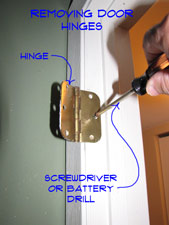 Replacing hinges is fairly easy. When you have three hinges, you can replace them one at a time without taking the door off.
Replacing hinges is fairly easy. When you have three hinges, you can replace them one at a time without taking the door off.
Before you replace them, make sure that adjustment or lubrications won't fix the problem.
See the articles 'Adjusting an Interior Door' and 'Adjusting Exterior Doors' for information on adjusting the hinges without replacing them. Also see, 'Lubricating Door Hinges' to see if you can get them working again.
Make sure you have the same size hinges and style of hinges before you try to replace them. See the article 'Types of Door Hinges' for more information.
Remove the screws for one of the hinges on both the door and the frame. Turn the new hinge with the head of the pin turned up. Make sure the hinge folds together the same way as the door will close. Put the hinge in place and install the screws. When the wood is worn, you may need to use a larger diameter or longer screw.
Repeat this process for all three hinges, one at a time. For two hinges, the procedure is similar, except you may want to take the door down and replace the hinges in halves. One half attaches to the frame and then the other half to the door. Use the old hinges as a guide.
The top hinge needs slightly different treatment. You may or may not have found a long screw in the top hinge. The long screw is usually on an inner hole and goes through into the wood framing for the jamb. See Step Four for more information on the top hinge. You want to put a long screw in, regardless of whether the old hinge had one. The long screw will not come with the replacement hinges, you will have to purchase it separately. A 2 1/2" #7 or #8 shanked screw with a wood thread is ideal.
Door Hinge Installation Concerns
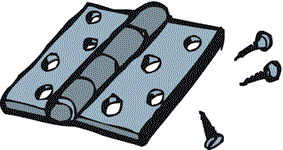 What door hinge installation means should be clarified. Replacing exising hinges is one possibility and installing hinges on a replacement door slab is a different job.
What door hinge installation means should be clarified. Replacing exising hinges is one possibility and installing hinges on a replacement door slab is a different job.
Most new doors are sold in a pre-hung format. The hinges are installed at the factory when the door is assembled. When you replace a door slab in an existing frame, you may have to mortise the hinges into the door. This involves laying out and chiseling. A bit more work.
This article is focused on repair situations that involve a door hinge installation. Remodeling projects and home improvements may also involve door hinges. Can you replace door hinges in your home when you need to? The answer is yes. Even when you have to do some chiseling, the job is not that hard.
What Can You Save? - A new set of hinges will run between $10 and $30 for residential grade hinges. Spring loaded and decorator hinges will run more. Replacing a pair of same size hinges will run between $50 and $75. A custom installation where the door has to be taken down and mortised will run around $100 to $150.
How Hard Could It Be? - Replacing the same size hinges on an existing door is fairly easy and can take less than a half an hour. Installing new hinges or hinges that are a different size will require 'mortising' (chiseling) door and frame to get them to fit. For and explanation of the terms in this section, see 'How to Use This Site'.
Check the Simple Things! - Lubricating sticking or squeaky door hinges is the simplest thing. See the article 'Fixing Squeaky Door Hinges', for information.
What Can Go Wrong? -Hinges need to be oriented a certain way. Installing them incorrectly will cause the door not to work. Taking a door down and not completing the task will leave you with a big hole in your wall. This could be critical for an exterior or bathroom door. Hinges need to be aligned properly on both the door and frame. Even a small difference can make it difficult or impossible to install the door.
Mortising Door Hinges
Can you mortise a door frame with a chisel for a door hinge installation? Yes you can. Do you really want to? Probably not.
You may have the unfortunate situation of having to buy hinges that are a different size than the old ones. You may need to widen the mortise where the hinge is seated.
When you are engaged in a door hinge replacement project you want to maintain a point of reference on the door and the frame. Leave one side of the mortise for the hinges intact on both the door and the frame. Your best choice would be the top of the hinge.
Remove the old hinges and use a new hinge as a template. Hold the hinge snuggly against the mortise at the top of the old hinges. Take a sharp pencil and draw an outline of the hinge on the door frame. You will repeat this process for all the hinges, always keeping the hinge aligned with the top of the old location.
Setting the Top Door Hinge
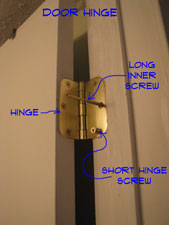 Most residential doors have two or three hinges. Does this mean that they have an equal share in the work? The answer to that question is No! The other hinges are there mostly to act as guides when the door opens. They keep it straight while it swings.
Most residential doors have two or three hinges. Does this mean that they have an equal share in the work? The answer to that question is No! The other hinges are there mostly to act as guides when the door opens. They keep it straight while it swings.
The top hinge carries the majority of the weight of the door. For a door hinge installation, you need to pay special attention to the top hinge. The door frame needs to be properly supported behind the top hinge. Most door manufacturers recommend that a long screw be used for the top hinge. This screw goes into the wood framework for the door.
Over time a door will start to sag. When the sagging gets bad enough the door won't close properly. When this happens, look to the top hinge first. A long screw back into the door jamb can work wonders for a sagging door.
For a door hinge installation, you want to make sure you install a long #8 screw in the top hinge. Usually 2 1/2" long will work. Go easy when you put this screw in, you can pull the door frame in too far. The long screw should go into one the inner holes on the hinge, to make sure it hits the stud for the jamb.
Summary
So how did your door hinge installation project go? Hopefully, you were able to find replacement hinges that were the same size and style as the ones you had. This makes the job a lot easier. Searching for exact matches can be hard when you have an old door. They can also get expensive.
Did you have to try to fit hinges that were a different size? You may have had to do a little chiseling to get the mortise to work. If you were careful this should have worked fine. Now that you are done with your door hinge installation project, you can think about other home repair jobs you have been putting off.
Door Hinge Sizes
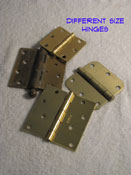 Door hinge sizes are an issue when purchasing new hinges. You will only want to do this if they need replacing.
Door hinge sizes are an issue when purchasing new hinges. You will only want to do this if they need replacing.
It is more likely that your door is out of adjustment, see 'Adjusting Interior Doors' or 'Adjusting Exterior Doors' for more information.
See 'Door Repair' for a complete listing of door topics.
The size and weight of the door will determine the size and number of hinges. Usually, you will replace the old ones with the same size and quantity.
A valid question. Most residential doors are between an 1 3/8" and 1 3/4" thick. So the normal size hinges for a residential door are 3" x 3" or 3 1/2" x 3 1/2". Your entrance doors might have 4" x 4" hinges, since the doors are heavier and usually thicker than the interior ones.
Measuring Door Hinge Sizes – You measure a door hinge when it is open and lying flat. The height is one dimension and the distance across both leaves is the other dimension. Butt door hinges are often the same size each way, but they don't have to be. It is possible to have hinges that are taller than they are wide. So it is a good idea to measure them both ways.
Is the hinge still on the door? Then you will have trouble getting a good measurement. You can also measure one side of the hinge from the edge of the hinge to the center of the pin. Take this dimension and double it to get the correct size.
Checking the Corners – There are more options, with different types of hinges, when it comes to the corners on the hinge. They might be square or they could have a radius. The square ones are easy, they are square. Both square and round corners are available with different door hinge sizes.
Radius corners are a more of a problem. They can be different radius's. The two common sizes for a radius on a door hinge is either 1/4" or 5/8". You should be able to use a tape measure to determine which size you have.
You may be wondering about the corners, why the difference? Rounded corners are made to fit into mortises that are cut with a router. Hinge jigs and commercial mortising machine use a round cutting head to cut out the mortise. So round corners are easier. They do have machinery that will cut square corners, but it involves another step.
Square corners are better when you are cutting the mortises with a chisel. Round corners are hard to do with a chisel. So there you have it, depending on the tooling you have, you may prefer, square or round corners. When replacing hinges, it makes things much easier to get the same size and style of hinge. Then you don't have to mess with the mortises at all.
So you have two things with the size that you need to make a note of. First the size of the hinges, height x width. Next the type and size of the corners on the hinge. When shopping for different types of hinges the best thing to do is take one of the old ones with you. Match them up at the store and you can't go wrong.
Purchasing Door Hinges
For a door hinge installation or replacement, you want hinges that are the same size and type as the one you have. The best practice is to take an old hinge with you when looking for replacements.
Even among hinges that are the same size, styles can vary. Spring loaded and ball bearing hinges are a couple of examples. See the article 'Types of Door Hinges', for an explanation of the various types and sizes of hinges.
Color and metal type are also important. A door with brass hardware, will likely have brass hinges. You may find stainless steel hinges that are the right size. It would be best to keep looking until you find the right metal finish.
Door hinges are measured by the dimensions when the hinge is open and lying flat. A 3 1/2" x 3 1/2" hinge will be 3 1/2" high, have a center pin and two plates that are approximately 1 1/2" wide. The common sizes for door residential door hinges are 3" and 3 1/2". They can come with both square and rounded corners. Most hardware stores and home supply stores will have a selection and stock the common sizes.
WARNING!! Doors Are Heavy, GET HELP When Removing a Door. Chisels Are Sharp, Use Caution!!! WARNING!!!
Summary
As you can see door hinges come in a number of sizes. See the articles, 'Adjusting Door Hinges', 'Replacing Door Hinges' and 'Squeaky Door Hinges' for related information.


